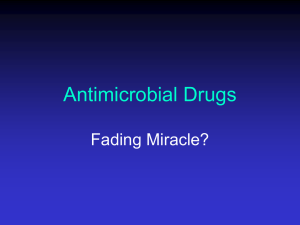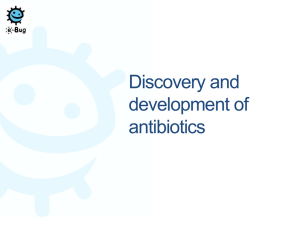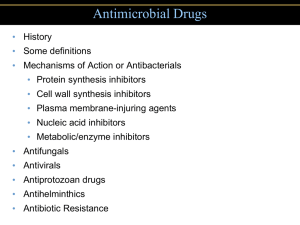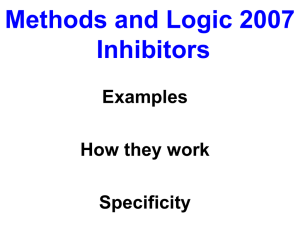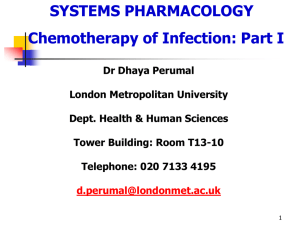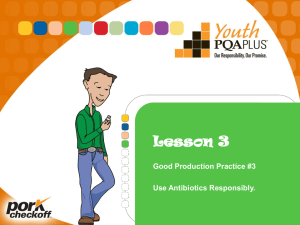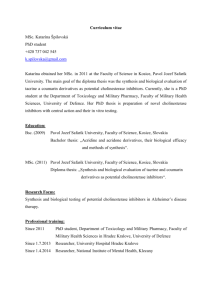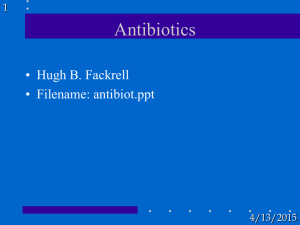10 Antimicrobial Therapy
advertisement
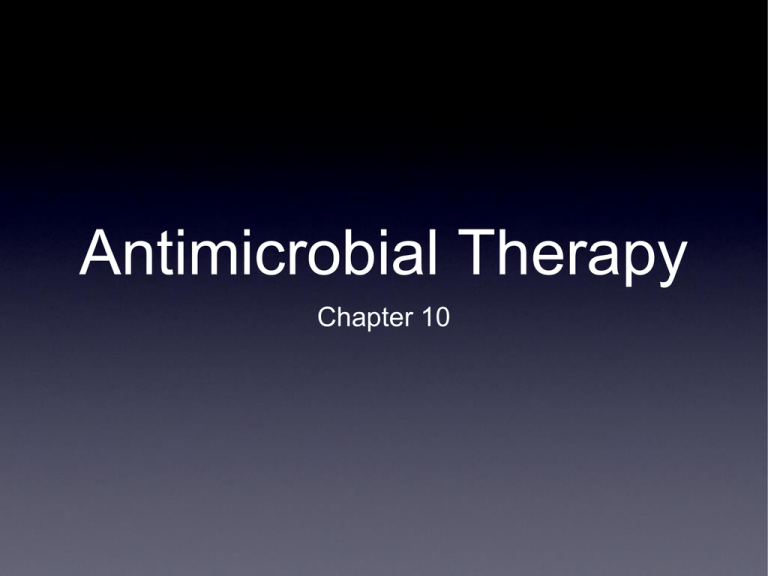
Antimicrobial Therapy Chapter 10 History of Antimicrobials • • • • 1600s Quinine for malaria Emetine for amebiasis (Entamoeba histolytica) 1900-1910 Arsphenamines for syphilis 1935 Sulfonamides - broadly active 1940 Penicillin - substantially more active than sulfa drugs Originally discovered in 1929 by Alexander Fleming (Scottish) Nobel Prize, 1945 Knighted, 1944 Produced by fungus Penicillium chrysogenum • • • • • • • • • Mechanisms of Action of Anitmicrobial Drugs • • Selective toxicity Antimicrobials must be toxic to the microbe, but not to the host Unfortunately, no such antibiotic exists Mechanisms of action Cell wall synthesis inhibitors Cell membrane inhibitors Protein synthesis inhibitors Nucleic acid synthesis inhibitors Metabolic Pathways • • • • • • • Cell Wall Inhibitors • Cell wall Outer layer of bacterial cell Barrier to outside Maintains osmotic pressure Peptidoglycan (polymer) Polysaccharide and cross-linked peptides (transpeptidation) N-acetylglucosamine (NAG) N-acetylmuramic acid* (NAM) *Only found in bacteria Synthesis of peptidoglycan layer is performed by several enzymes Gram+ have substantially thicker peptidoglycan layer • • • • • • • • • • Cell Wall Inhibitors • Penicillin and Cephalosporin Highly insoluble in natural form Usually converted to a salt to increase solubility Contains a β-lactam ring that interferes with cell wall synthesis Penicillin is first bound by cellular penicillin binding receptors (PBP) This binding interferes with transpeptidation reaction This prevents peptidoglycan synthesis • • • • • • Cell Wall Inhibitors Semisynthetic penicillins Cell Membrane Function Inhibitors • • • • The cell membrane is a biochemically-rich compartment Polymyxins Contain detergent-like (amphipathic) cyclic peptides These damage membranes containing phosphatidylethanolamine Novobiocin - inhibits teichoic acid synthesis Ionophores - disrupt ion transport Discharge membrane potential Disrupts oxidative phosphorylation • • • • Protein Synthesis Inhibitors Protein Synthesis Inhibitors • Most interfere with ribosomes • By preventing ribosome function, polypeptide synthesis is inhibited • Compounds • • Aminoglycosides (e.g., streptomycin) Bind to 30S subunit Interferes with initiation complex mRNA localization to P site fMet tRNA Incorrect amino acid is incorporated into polypeptide Tetracyclines Bind to 30S subunit Prevents IF3 binding No tRNA binding • • • • • • • • Protein Synthesis Inhibitors • Others • • • • • • • • Macrolides - initiation complex, translocation Azalides - initiation complex, translocation Ketolides - initiation complex, translocation Lincomycins - initiation complex, translocation Glycylcyclines - Tet analogs; bind with higher affinity Chloramphenicol - Inhibits peptidyl transferase Streptogramins - Irreversible binding to 50S subunit; unknown mechanism Oxazolidinones - Inhibit fMet tRNA binding to P site Nucleic Acid Synthesis Inhibitors • • • • Types DNA/RNA polymerase inhibitors Base analogs Rifampin Binds with high affinity to β subunit of DNA-dependent RNA polymerase Prevents RNA synthesis Quinolones - inhibit bacterial DNA gyrase Sulfonamides Structural homologs of p-aminobenzoic acid (PABA) PABA is required for folic acid synthesis by dihydropteroate synthetase (DHPS) Folic acid is a nucleotide precursor Sulfa compounds compete with PABA for the active site of DHPS • • • • • • • • Nucleic Acid Synthesis Inhibitors DHPS Resistance to Antimicrobial Drugs • Mechanisms of resistance Enzymes that cleave or otherwise inactivate antibiotics β-lactamases Changes in bacterial permeabilities Prevents entry of antibiotic into cell Mutation in target molecule Alter binding characteristics of the antibiotics Alteration of metabolic pathways Some resistant bacteria can acquire PABA from the environment Molecular pumps (efflux systems) Secretion systems that export antibiotics faster than the rate of import • • • • • • • • • • Nongenetic Origins of Drug Resistance • • • Low replication rates Antibiotic is metabolized or neutralized before it act Mycobacteria spp. Alteration of cellular physiology Bacterial L forms are cell wall-free Streptococcus spp., Treponema spp., Bacillius spp., others Colonization of sites where antibiotics cannot reach Gentamicin cannot enter cells Salmonella are thus resistant to gentamicin • • • • • • Genetic Origins of Drug Resistance • Chromosomal Resistance Genes that regulate susceptibility Often found in enzymes, rRNA and secretion system genes Mutations in RNApol render it resistant to the effects of rifampin Efflux pumps with specificity for antibiotics Found in all bacteria All possess large hydrophobic cavity for binding antibiotics • • • • • • Five efflux pumps (“antiporters”) that regulate antibiotic resistance (Paulsen, 2003) Genetic Origins of Drug Resistance • Extrachromosomal Resistance Often account for interspecies acquisition of resistance Contribute to multi-drug resistance (MDR) Genetic elements are: Plasmids Transposons Conjugation Transduction Transformation • • • • • • • • Drug Resistance Antimicrobial Activity In Vivo • Drug-Pathogen Relationships Environment State of metabolic activity: slow-growing or dormant bacteria less susceptible Distribution of drug: CNS is often exclusionary Location of organisms: Some drugs do not enter host cells Interfering substances: pH, damaged tissues, etc. Concentration Absorption: some cannot be taken orally Distribution: some accumulate in certain tissues Variability of concentration: peaks and troughs Postantibiotic effect: delayed regrowth of bacteria • • • • • • • • • • Antimicrobial Activity In Vivo • Host-Pathogen Relationships • Alteration of tissue response • Suppression of microbe can reduce inflammatory responses • Alteration of immune response • Prevention of autoimmune antibodies (e.g., rheumatic fever) • Alteration of microbial flora • Expansion of harmful flora (e.g., C. difficile) Clinical Use of Antibiotics • Selection of appropriate antibiotic Accurate diagnosis is critical Susceptibility testing should be performed if: Isolated microbe is often antibiotic resistant Infection would likely be fatal if incorrect drug is selected Need rapidly bactericidal activity (e.g., endocarditis) Susceptibility testing is often performed with antibiotic discs A large zone of clearance suggest sensitivity • • • • • • • • necessary to kill or retard bacteria • It is usually done as a tube test (i.e., liquid phase) • Serial dilutions of an antibiotic is made, then a Minimal Inhibitory Concentration The MIC determines the dose of antibiotic • defined number of bacteria are added to the tubes Tubes are read the following day (or days) for the endpoint Minimal Inhibitory Concentration Dangers of Indiscriminate Use • In some countries antibiotics are available OTC • This has led to the emergence of antibiotic resistance • Often the wrong antibiotic is used • The full regimen is not completed • Hypersensitivities (e.g., penicillin anaphylaxis) • Hepatotoxicity • Changes in normal flora Antimicrobial Chemoprophylaxis • Exposure to specific pathogens (e.g., N. meningitidis) • Health-related susceptibilities • Heart disease/valve replacement • Respiratory disease (e.g., influenza, measles) • Recurrent urinary tract infections • Opportunistic infections • Post surgery • Disinfectants • Medical devices (e.g., catheters) Antifungal Drugs Antiprotozoal and Antihelminth Drugs Antiprotozoal and Antihelminth Drugs Toxic Side Effects • • • • • • • Penicillins: Hypersensitivity Cephalosporins: Hypersensitivity, nephritis, hemolytic anemia Tetracyclines: Discoloring of teeth Chloramphenicol: Disruption of RBC production Erythromycins: Hepatitis Vancomycin: Deafness, leukopenia, renal damage Sulfonamides: Hemolytic anemia, bone marrow depression



